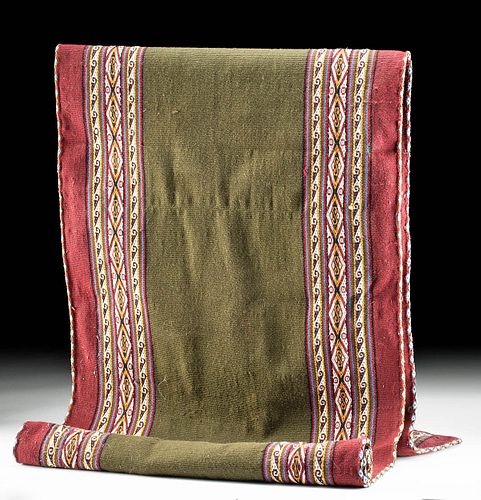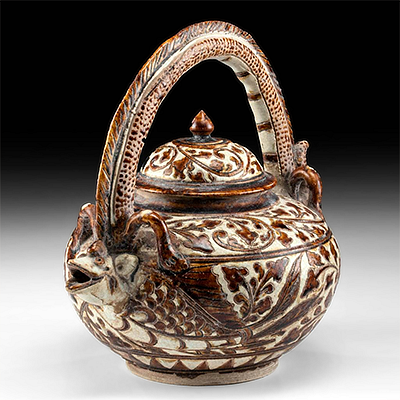20th C. Bolivian Aymara Woven Wool Textile
Lot 109
About Seller
Artemis Fine Arts
686 S Taylor Ave, Ste 106
Louisville, CO 80027
United States
Selling antiquities, ancient and ethnographic art online since 1993, Artemis Gallery specializes in Classical Antiquities (Egyptian, Greek, Roman, Near Eastern), Asian, Pre-Columbian, African / Tribal / Oceanographic art. Our extensive inventory includes pottery, stone, metal, wood, glass and textil...Read more
Estimate:
$800 - $1,200
Absentee vs Live bid
Two ways to bid:
- Leave a max absentee bid and the platform will bid on your behalf up to your maximum bid during the live auction.
- Bid live during the auction and your bids will be submitted real-time to the auctioneer.
Bid Increments
| Price | Bid Increment |
|---|---|
| $0 | $25 |
| $300 | $50 |
| $1,000 | $100 |
| $2,000 | $250 |
| $5,000 | $500 |
| $10,000 | $1,000 |
| $20,000 | $2,500 |
| $50,000 | $5,000 |
| $100,000 | $10,000 |
| $200,000 | $20,000 |
About Auction
By Artemis Fine Arts
Jul 1, 2021
Set Reminder
2021-07-01 10:00:00
2021-07-01 10:00:00
America/New_York
Bidsquare
Bidsquare : Antiquities | Asian | Ethnographic Art
https://www.bidsquare.com/auctions/artemis-gallery/antiquities-asian-ethnographic-art-7148
Featuring classical antiquities, ancient and ethnographic art from cultures encompassing the globe. Egyptian, Greek, Roman, Near Eastern, Asian, Pre-Columbian, Native American, African / Tribal, Oceanic, Spanish Colonial, Russian, Fossils, Fine Art, more! All legally acquired, legal to sell. Artemis Fine Arts info@artemisfinearts.com
Featuring classical antiquities, ancient and ethnographic art from cultures encompassing the globe. Egyptian, Greek, Roman, Near Eastern, Asian, Pre-Columbian, Native American, African / Tribal, Oceanic, Spanish Colonial, Russian, Fossils, Fine Art, more! All legally acquired, legal to sell. Artemis Fine Arts info@artemisfinearts.com
- Lot Description
South America, Bolivia, Aymara (Aimara) people, ca. early to mid-20th century CE. A beautiful wool textile that displays traditional dying and weaving techniques perfected over hundreds of years. The piece is comprised of finely woven fibers of wool from a sheep or camelid, such as llama or alpaca. The threads are dyed in lovely muted tones with some brighter contrasts in hues of moss green, wine red, yellow, brown, blue, red, black, and beige. The center is a solid green and the edges are embroidered with diamond shaped patterns. The patterning along the edges is a intricate motif of waves and geometric shapes with alternating bands of colors. This would be a wonderful piece to display, such as a table runner or wall tapestry. Size: 64" L x 17" W (162.6 cm x 43.2 cm)
The Aymara are an indigenous group who live in Bolivia, Peru, and Chile, in the Altiplano, mostly in the high-altitude valley around Lake Titicaca. They are famous for their many different styles and types of woven textiles, which they have made for thousands of years. After the arrival of the Spanish, Aymara woven textiles became a way for indigenous people to mark their identity - first, as a symbol of status for Mestizos who could not afford European textiles, and then as a way of showing rebellion to the Spanish after other forms of clothing were outlawed following native uprisings. Today they continue to make these beautiful textiles, which have gained worldwide acclaim.
Provenance: private Newport Beach, California, USA Collection
All items legal to buy/sell under U.S. Statute covering cultural patrimony Code 2600, CHAPTER 14, and are guaranteed to be as described or your money back.
A Certificate of Authenticity will accompany all winning bids.
We ship worldwide and handle all shipping in-house for your convenience.
#141325Fraying and pulling of threads along central panels and peripheries. Loosening and unraveling of bright red threads. Pilling to surfaces. Nice preservation of motifs and colors.Condition
- Shipping Info
-
All shipping is handled in-house for your convenience. Your invoice from Artemis Gallery will include shipping calculation instructions. If in doubt, please inquire BEFORE bidding for estimated shipping costs for individual items.
-
- Buyer's Premium



 EUR
EUR CAD
CAD AUD
AUD GBP
GBP MXN
MXN HKD
HKD CNY
CNY MYR
MYR SEK
SEK SGD
SGD CHF
CHF THB
THB














